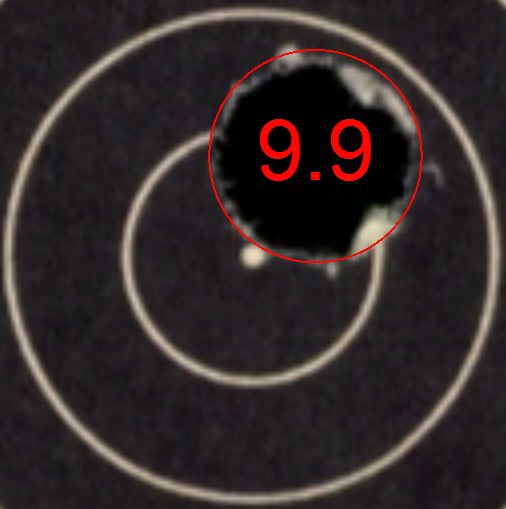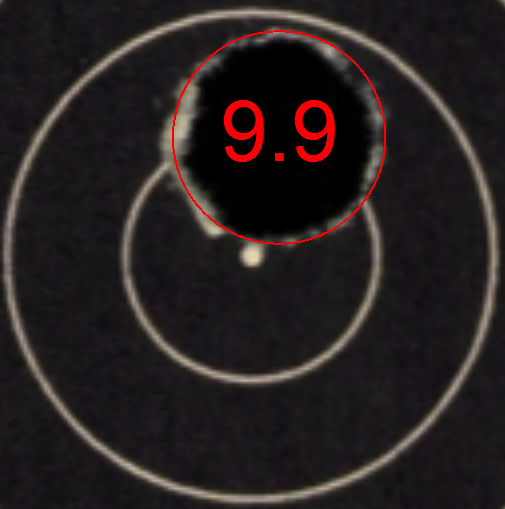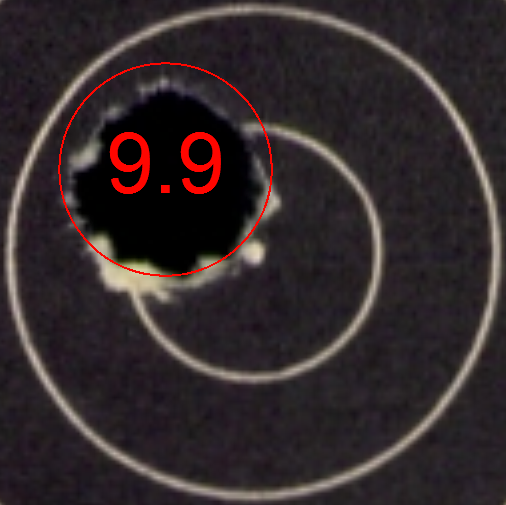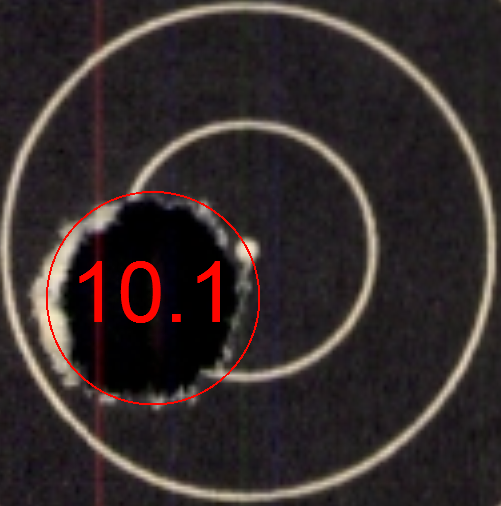This essay examines the widespread use of challenges in paper target scoring and explains why those traditional challenge procedures are inappropriate, unfair, and unsportsmanlike when used in matches where electronic scoring systems are used.
The Historical Role of Challenges.
Prior to electronic scoring there was only manual scoring for paper targets. While manual scoring of paper targets can be accurate, consistent manual scoring accuracy is very difficult to achieve. It requires quality targets, consistent gauge (plug) diameters and, most importantly, skilled scorers. Especially at the local club level, match directors usually find it impossible to fulfill these requirements for consistent, accurate manual paper target scoring. Scorers are often day volunteers who can only be given “10 minutes of training” before scoring real targets. Using the same scorers for an entire match is often impossible. Moreover, scorers are human; they become tired and sometimes careless. This situation has persisted for decades and results in frequent scoring errors and inconsistencies. Often the only way a shooter can get a fair score in manual target scoring is through “challenges” that provide for rechecking shots that should have been scored correctly. Sadly, the need to use challenges to correct scoring errors mutated into a widespread ethos in the USA that regards making “challenges” to gain points as just "part of the game." Unfortunately, this reliance on challenges fails to recognize the root cause of the problem, that challenges were only necessary due to the poor quality of manual scoring. If scoring is accurate, fair, and equal, there should be no need for challenges.
Accuracy of Electronic Scoring.
A key concept to understand is that there is no such thing as a “perfect scoring system.” Every scoring system makes some microscopic errors. The type, magnitude, and cause of these errors differ from one scoring system to the next, but all scoring systems have errors. Even if one could magically reproduce the exact same shot and score it with the exact same system at a later time, factors minute as temperature, humidity, and dust will cause scoring differences.
The term “score” when used in the context of an electronic scoring system does not intrinsically mean that a shot is a 10, 9, 8, etc. in relation to printed scoring rings on a target. Rather “score” means the radial location of the shot center relative to the target center as calculated by the scoring system. The score of a shot scored electronically is the distance from the center of the shot hole to the center of the aiming bull. This is also known as the “radial distance.” The “score value” is derived from the calculated radial distance.
Instead of requiring the impossible standard of a “perfect” scoring system, shooting governing bodies require scoring systems to score within an allowable tolerance. For example, at the highest level of competition, the International Shooting Sports Federation (ISSF) requires electronic targets to score within one half of one decimal ring. On an Air Rifle target this means a maximum scoring error of .125mm is acceptable. The tested scoring accuracy of the Orion Scoring System is well within this international standard. We must also note that the practical accuracy of manual scoring will almost never meet this international standard.
These allowable scoring errors, that is, permissible small differences in calculated radial distances, are enough to cause an occasional 10, when scored on an imaginary “perfect” target, to score as a 9 on a real target. And vice-versa, an occasional 9, when scored on an imaginary “perfect” target will score as a 10 on a real target. Over the course of a full event these errors usually cancel each other out, especially when decimal scoring is used.
To be considered fair, a real scoring system does not have to produce the exact same score value on every shot as its imaginary perfect counterpart. Instead, as long as a real scoring system scores all shots within the allowable tolerance, the results are considered fair and comparable.
The Role of “Obvious Errors” in Orion.
If a shot is scored within this allowable tolerance, it is considered a “correctly scored shot.” Again, this does not mean that a scored shot will have the same score value as it would be given with an imaginary perfect target, rather that the scored shot is within the allowable scoring tolerance. In rare cases, an electronic scoring system will score a shot outside of the allowable scoring tolerance. This is true for all electronic scoring systems. Competition rulebooks have specific rules to govern how match officials must deal with these “incorrectly scored shots.” Electronic scoring targets use witness strips or backing cards to help catch these errors. Target reading machines or systems like Orion use the original target and the scanned target image to catch these errors.
With Orion the term “obvious error” is synonymous with “incorrectly scored shot.” This is because if a shot is scored outside of the allowable tolerance, this error will be obvious to the Statistical Officer when it is reviewed within the software. In Orion, the “scored shot” is represented with a red or blue circle. The “actual shot” is the shot hole as seen in the scanned and digitized target image. When the two reasonably correspond with each other it is a correctly scored shot. When the scored shot is not a reasonable representation of the actual shot hole then it is an obvious error.
When a shot’s score is questioned, it is the responsibility of the Statistical Officer (Orion user) to make a decision as to whether that shot is a correctly scored shot or an obvious error. When an obvious error does occur within Orion, the Statistical Officer can and should in all instances correct the obvious error. The functions for making such manual interventions are built into Orion.
Examples of correctly scored shots. There are not obvious errors.


Examples of obvious errors. The stat officer should make a manual correction in these instances.


Scoring Rings Cannot Be Used to Judge the Value of an Orion-Scored Shot.
The scoring rings printed on the target are not relevant to the score value Orion assigns to a shot. The scoring rings are only there so shooters will have a reference to adjust sights and know their approximate scores. While a scored shot may appear to touch a printed scoring ring, this by itself cannot be used to claim Orion made a scoring error. Orion and paper targets use two different methods of scoring. Orion measures the distance from the center of the aiming bull to the center of the shot hole. Paper target scoring compares the edge of a shot hole with the edge of a scoring ring and is subject to its own inaccuracies. One method cannot be used to check the other. What must be checked instead is whether Orion’s scored shot is a reasonable interpretation of the actual shot hole; that is, did Orion find the shot hole correctly or make an obvious error.
Statistical Officer’s Responsibility for Neutrality.
Statistical Officers who operate the Orion system bear a great deal of responsibility. This is because they must judge what is or what is not an obvious error and make appropriate manual corrections only when warranted. Thankfully obvious errors are rare. Nevertheless, when shots are questioned, it is important that Statistical Officers conduct themselves in a precise, professional, and neutral manner while practicing the highest standards of integrity. Since it is impossible for a Statistical Officer to quantitatively measure the accuracy of a given shot he or she must instead rely on their qualitative judgment when determining obvious errors. Statistical Officers must never be influenced by shooter’s or coach’s arguments, the score value of a shot, or any personal feelings for or against a competitor.
Statistical Officers should only judge obvious errors based on the relationship between the scored shot and the actual shot. If the scored shot is a reasonable interpretation of the actual shot then it is a correctly scored shot. When a Statistical Officer decides that the scored shot is not a reasonable interpretation of the actual shot and must make a manual intervention, he or she should only move the scored shot so that it aligns with the actual shot. It is entirely possible that even after a manual correction the score value will remain the same.
Statistical Officers are analogous to instant replay referees in other sports. They are looking for incontrovertible evidence to overturn a score. One Statistical Officer may interpret a shot slightly different from another Statistical Officer. The reality is that a Statistical Officer will also infrequently misjudge obvious errors. Their judgment, whether right or wrong, is part of the sport and their decisions are final. Every sport has these types of referee decisions, this just happens to be shooting’s version of a referee call.
Challenging Electronically Scored Shots is Unsportsmanlike.
When Orion scoring is used, there is a difference between “questioning” a shot by asking the Statistical Officer to determine if an “obvious error” occurred and “protesting” or “challenging” a close shot to have it re-scored in hopes of obtaining a higher score in the re-score. In the context of electronic scoring systems, a challenge has a very different meaning than it has with manual paper target scoring. With manual scoring, a challenge may be used when a scorer makes an obvious error or fails to gauge a close shot; many manual scoring rules prohibit the re-scoring of previously gauged shots. Obvious errors very rarely occur with electronic scoring. In systems like Orion, if an obvious error does occur, the Statistical Officer should automatically make a manual correction without requiring the payment of a protest or challenge fee; correcting obvious errors is part of the correct use of Orion. Challenges are instead reserved for when a shooter wants to re-score a shot in hopes of achieving a higher score value.
By selecting for challenges and re-scoring only those shots that are extremely close to scoring a higher value (close 9.9s, etc.), a shooter can “game” or cheat the system. Since every scoring system has its own minute, intrinsic errors, the resulting re-scored value might change to the shooter’s advantage if the shot center lies within the allowable tolerance of the scoring system. This type of challenge is fundamentally unsportsmanlike because it is done by selecting for re-scoring only those shots that are exceptionally close and have a chance to go up in value. The challenging shooter never selects close shots for re-scoring that would have a chance to go down in value (close 10.0s, 9.0s, etc.). This factor alone makes the tactic of attempting to “buy points” unfair and unsportsmanlike. For some shooters to pursue point buying strategies is also unfair to other shooters who accept their correctly scored shots as being fair and equal for all competitors.
This type of challenge is also now very risky because governing bodies like USA Shooting and the National Three-Position Air Rifle Council have introduced 2-point penalties for lost challenges as a way to discourage this unsportsmanlike practice. Governing bodies in other countries that use electronic scoring of paper targets go even further. They permit score protests only for obvious errors and do not permit the re-scoring of any correctly scored shots (no challenges, period). The International Shooting Sport Federation applies a similar 2-point penalty for lost score protests on shots scored by electronic scoring targets. These penalties are necessary because it simply is not fair for a shooter to overlook an extremely close shot that was scored in his favor, but then lay his money down to challenge shots that were not scored in his favor. This practice does not belong in our game.
Challenging a correctly scored shot is unsportsmanlike.
This essay was created by Erik Anderson, Ph.D, creator of Orion Scoring System and Schooter's Technology, LLC.